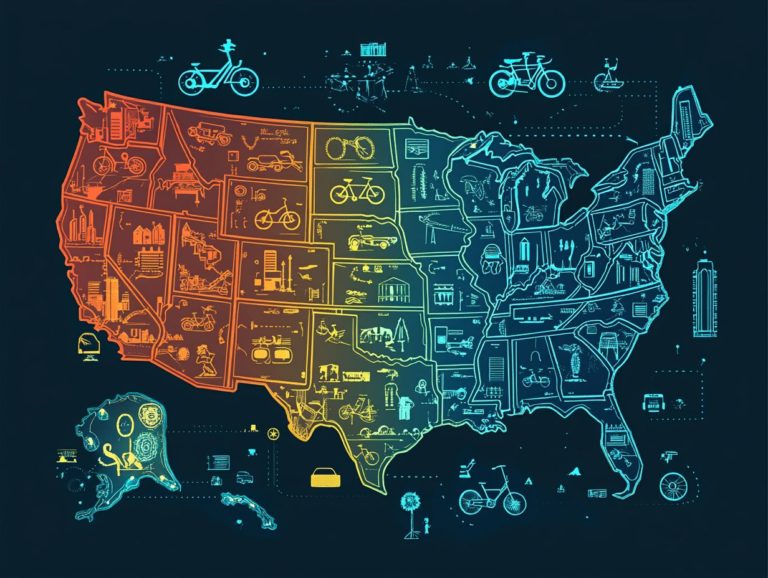Electric Bicycle Path Regulations: A Complete Guide
Electric bicycles, or electric bikes, are changing how you navigate your city. They offer an eco-friendly and efficient alternative to traditional transportation.
As their popularity grows, it’s important to understand e-bike laws and electric bicycle paths. This article covers the definition and purpose of these paths, the differences between separate and shared paths, and the essential state regulations governing their use.
Discover the many benefits of electric bicycle paths and address challenges like safety and congestion. Let s explore what you need to know about bike paths designed for electric bicycles!
Contents
- Key Takeaways:
- Understanding Electric Bicycle Paths
- Types of Electric Bicycle Paths
- Separate Paths vs Shared Paths
- Regulations for Electric Bicycle Paths
- Speed Limits and Traffic Rules
- Requirements for Electric Bicycles
- Benefits of Electric Bicycle Paths
- Challenges and Solutions
- Frequently Asked Questions
- 1. Are electric bicycles allowed on all bike paths?
- 2. Do electric bicycles have a speed limit on bike paths?
- 3. Are there any age restrictions for riding electric bicycles on bike paths?
- 4. Do I need a license to ride an electric bicycle on bike paths?
- 5. Are there any specific safety regulations for riding electric bicycles on bike paths?
- 6. Can I ride an electric bicycle on a bike path if I have a disability?
Key Takeaways:

- Electric bicycle paths promote sustainable and efficient transportation options.
- Understanding the differences between separate and shared paths ensures safety for e-bike riders and pedestrians.
- Regulations like speed limits and licensing requirements help maintain safety on these paths.
Understanding Electric Bicycle Paths
Understanding electric bicycle paths is essential for any eager rider. These paths are designed specifically for e-bike classes and electric bikes.
They not only protect your journey but also encourage responsible e-bike use. Various state regulations and local guidelines shape these paths.
Cities like California and New York City are creating more e-bike-friendly infrastructures. Organizations such as PeopleForBikes support policies that enhance accessibility and prioritize e-bike safety.
Definition and Purpose
Electric bicycle paths are special routes for electric bikes. They fall into classes such as Class 1, Class 2, and Class 3, which may include features like pedal-assist, where the bike helps you pedal, and throttle-assist, which allows you to control speed without pedaling.
These pathways enhance your riding experience while prioritizing safety. You can navigate various terrains while following helmet laws and local regulations.
These paths promote using e-bikes for commuting, recreation, and fitness. They contribute to environmental sustainability and encourage a vibrant community among e-bike enthusiasts.
Types of Electric Bicycle Paths
There are several types of electric bicycle paths to meet the growing demand for e-bikes. These include dedicated paths exclusively for e-bikes and shared pathways that encourage safe coexistence between cyclists and pedestrians.
Separate paths for electric bicycles are crafted specifically for e-bike use, enhancing safety for riders while adhering to local regulations. Shared paths accommodate a mix of cyclists, pedestrians, and e-bikes, promoting road usage.
This distinction can make your ride safer and more enjoyable! Dedicated routes can dramatically lower the risk of accidents by minimizing interactions between different types of users. When you navigate a path designed exclusively for e-bikes, you create a more predictable riding environment, enhancing your overall experience and ensuring compliance with e-bike safety practices.
Shared paths offer their own advantages, promoting greater accessibility and interaction among various modes of transportation. However, local regulations play a pivotal role in shaping these dynamics. In areas where regulations favor shared paths, the safety of all users may be at risk if enforcement is lacking, potentially leading to conflicts and hazards.
Regulations for Electric Bicycle Paths

Understanding the regulations governing electric bicycle paths, including e-bike insurance requirements, is essential for you, whether you’re a rider or a city planner. State regulations dictate speed limits, helmet laws, and licensing requirements, varying significantly from one jurisdiction to another.
Stay informed to ensure a safer and more enjoyable experience for everyone involved.
Speed Limits and Traffic Rules
Speed limits and traffic rules for electric bicycle paths are designed to ensure everyone’s safety. They vary significantly from one region to another, shaped by local regulations and e-bike laws.
These regulations reflect the unique characteristics of each community, considering factors like population density, road conditions, and typical behaviors of cyclists and motorists, especially concerning age restrictions on e-bike use. For you as an e-bike rider, compliance with these rules is essential not just for your own safety, but for the well-being of pedestrians and drivers of conventional vehicles. To better understand the different options available, check out the electric bicycle types that suit your needs.
Knowing the speed limits helps keep everyone safe on the roads. By understanding and adhering to the speed limits and regulations on designated paths, you can greatly reduce the risk of accidents and foster smoother coexistence on urban roadways.
Some areas impose lower speed limits in high-traffic zones while allowing for higher speeds on dedicated bike lanes, which can differ based on California e-bike regulations. Familiarizing yourself with your local California e-bike regulations is crucial to ensure a safe and enjoyable riding experience. If you’re considering an electric bike, check out electric road bikes: the ultimate buying guide for valuable insights.
Requirements for Electric Bicycles
Requirements for electric bicycles often entail adhering to specific e-bike classes, which dictate licensing needs and age restrictions while promoting safety through helmet laws.
These classes categorize e-bikes based on their power output and maximum speed, resulting in varying state regulations across states and countries, as stipulated by the Consumer Product Safety Commission (CPSC). For those new to e-bikes, exploring electric bicycle types can be helpful. Depending on the classification, you may need to obtain a special license or register your e-bike with local authorities. Age restrictions can differ; younger riders might only be allowed to operate certain types of e-bikes under specific conditions.
Understanding these rules is vital for anyone eager to ride legally and safely, ensuring you can fully enjoy your electric bike while remaining compliant with local regulations. To learn more, check out our quick guide on electric bicycle classification.
Benefits of Electric Bicycle Paths
Electric bicycle paths offer numerous benefits for you to enjoy. They not only enhance the safety of e-bike riders but also contribute to environmental sustainability by reducing vehicular emissions and supporting public lands initiatives.
These paths also promote your health by encouraging regular physical activity, fostering a healthier lifestyle for you and your community.
Environmental and Health Benefits
The environmental advantages of electric bicycle paths are striking. They significantly reduce carbon footprints and foster eco-conscious commuting.
On the health front, regular riding enhances cardiovascular fitness, positively impacting e-bike safety on the roads.
Research shows that swapping car trips for e-bike rides can diminish carbon emissions by as much as 30%. This marks a notable step toward sustainable urban transport and reinforces the goals set by organizations like PeopleForBikes.
The British Journal of Sports Medicine states that regular cycling can reduce the risk of heart disease by approximately 50%.
Communities are quickly realizing the benefits of dedicated e-bike paths. They promote a healthier lifestyle and encourage eco-conscious commuting.
This compelling interplay between increased physical activity and reduced dependence on automobiles makes a strong case for embracing electric biking as a sustainable alternative. It benefits both the environment and individual health.
Challenges and Solutions

Addressing the challenges associated with electric bicycle paths necessitates a careful approach to safety concerns, congestion management, and understanding e-bike laws.
As e-bike laws and local regulations evolve to accommodate the increasing number of riders, it’s crucial to stay informed and proactive, especially regarding California‘s e-bike regulations.
Addressing Safety Concerns
Addressing safety for electric bicycles requires adherence to helmet laws and local regulations that promote e-bike safety on both shared and separate paths.
These regulations are vital for ensuring adequate protection while navigating urban environments or rural trails. Compliance with helmet laws is essential.
E-bike safety isn t just about wearing a helmet. It also involves using proper lighting, wearing reflective gear, and being well-informed about road rules.
Local jurisdictions are rolling out educational programs to raise awareness of these essential practices. By fostering a culture of safety that emphasizes responsible riding and understanding age restrictions, you can significantly reduce accident rates and enhance the experience for cyclists and pedestrians.
Managing Congestion and Conflict
Managing congestion on electric bicycle paths demands a carefully crafted approach to road usage, grounded in e-bike laws and local regulations.
As their popularity continues to soar, particularly along trails like the Marvin Braude Bike Trail and American River Bike Trail, comprehensive strategies are essential.
Local authorities must encourage safe coexistence among cyclists, motorists, and pedestrians. Implementing effective signage, designated lanes, and awareness campaigns will improve understanding among all road users.
Acknowledging unique regulations governing e-bikes, like speed limits and age restrictions, will help reduce potential conflicts on the road.
Engaging the community in discussions about these regulations cultivates a sense of shared responsibility. This paves the way for smoother traffic flow and enhanced safety for everyone involved, especially on popular trails like the Marvin Braude Bike Trail and the American River Bike Trail.
Frequently Asked Questions
1. Are electric bicycles allowed on all bike paths?
In cities like New York and California, e-bike regulations vary widely.
It depends on the specific regulations in your location. Some areas may allow electric bicycles on all bike paths, while others may only allow them on certain designated paths. It’s important to research and follow the regulations in your area.
2. Do electric bicycles have a speed limit on bike paths?

The speed limit varies by location. In some areas, electric bicycles share the same limit as regular bikes, while others allow higher speeds. Check your local rules before you ride!
3. Are there any age restrictions for riding electric bicycles on bike paths?
Age restrictions for electric bicycles typically match those for regular bicycles. Always confirm with local authorities to ensure you re compliant.
4. Do I need a license to ride an electric bicycle on bike paths?
Whether you need a license depends on where you live. Some places require it, while others do not. Research your local laws to stay informed!
5. Are there any specific safety regulations for riding electric bicycles on bike paths?
Yes, safety rules are usually in place for electric bike riders. These often include wearing a helmet and obeying traffic laws. Familiarize yourself with these guidelines before hitting the path!
6. Can I ride an electric bicycle on a bike path if I have a disability?
Electric bicycles are generally allowed on bike paths, even for riders with disabilities. However, it’s wise to check with local authorities for any specific rules or accommodations.




